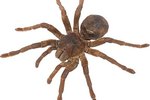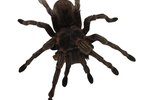
Arachnophobia -- fear of spiders -- is a common phobia, even though among approximately 40,000 species of spiders only a handful pose dangers to people. Insecticides are stronger than even the most potent spider venom. Spiders have various ways of defending themselves against most predators except humans.
Run and Hide

Most animals, including humans, have the "fight or flight" instinct but a few will pick a fight if given half the chance. Spiders are no exception and will quickly run away and hide if they are threatened by a predator such as a bird, reptile, amphibian or even another spider. Some insects also eat spiders. Wasps, for example, are higher on the pecking order than some spiders. Humans are by far the worst enemy spiders have, which is ironic since spiders are so beneficial to people. They eat many of the destructive insects that destroy crops, a pretty important resource to the survival of mankind.
Venom

Almost all spiders with the exception of a few species -- those belonging to the uloboridae, holarchaeidae and mesothelae families -- are venomous. Their fangs are designed in such a way as to inject venom when they bite. The difference between venom and poison is that venom is injected, as with a bite, while poison is ingested, as when a dog licks a poisonous bufo toad. Most spiders do not have big enough fangs or enough venom to hurt a human, but can sure cause a lot of pain and even death to a much smaller critter, like a bird or lizard. Some of the larger species of spiders have fangs big enough to cause a very painful, but not venomous bite, even to humans. Some spiders' venoms will cause allergic reactions. Others' venom attack the victims' nervous systems. Still others have venom that causes the victim's skin to become necrotic.
Camouflage
Many spiders are colored in such a way as to blend in with their surroundings. Spiders with shades of black, grey or brown can easily blend in with trees, dirt and rocks. Since many of the predators that prey on spiders only strike when they see something moving, spiders will stay perfectly still and blend in until the predator goes away. If spotted, spiders can also drop a line of silk and "fall" from great heights a lot faster than some predators can move. Spiderman does it all the time!
Spiders are also predators whose prey drive is triggered by movement. When flies or other insects are caught in a spider's web, it's the struggling and the movement that gets the spider's attention.
Clever Defenses
Some spiders defend themselves in strange ways indeed. Certain tarantulas have urticating hairs on their bellies. These hairs have barbs on them which cause irritation and pain. These spiders can actually shoot the hairs by rubbing their legs against their abdomen. When they aim for the victim's eyes, they can potentially blind the victim long enough to get away.
The golden wheeling spider, found in the desert of Namibia in South Africa, can actually stand on its legs, turn sideways and cartwheel away from a predator. Orb spiders make body doubles of themselves out of dead bugs and silk to defend themselves from predators while in their webs. The green lynx spider can spit venom up to a foot away, so you don't have to even come in contact with it to become a victim.
References
Photo Credits
-
Hemera Technologies/Photos.com/Getty Images
Writer Bio
Michelle A. Rivera is the author of many books and articles. She attended the University of Missouri Animal Cruelty School and is certified with the Florida Animal Control Association. She is the executive director of her own nonprofit, Animals 101, Inc. Rivera is an animal-assisted therapist, humane educator, former shelter manager, rescue volunteer coordinator, dog trainer and veterinary technician.


